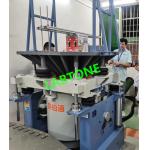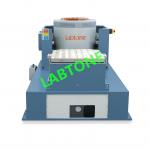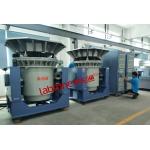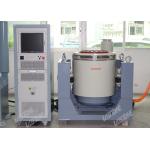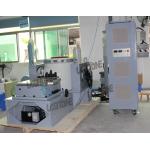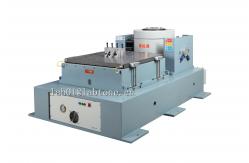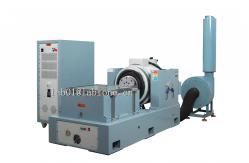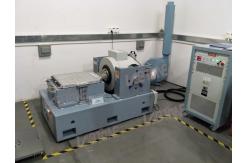Vibration Testing Equipment Simulate Real Life Environmental with
Random Vibration
Vibration Shaker
This test system generates vibration according to the parameters
such as arbitrary force, acceleration, and frequency. It can
evaluate various industrial products by applying vibration load.
Vibration test system for evaluating industrial products against
vibrations. The system consists of a vibration generator, a
power amplifier, and a vibration control system. It can provide a
vibration test to cope with various loads such as sine vibration,
random vibration, mechanical shock pulse and replication of
real-time trace.
Standard Models: EV203-EV220
| Model | EV203 | EV206 | EV210 | EV220 |
| Vibration Generator | VG300/40 | VG300/50 | VG1000/50 | VG2000/50 |
| Frequency(Hz) | 2-2500 | 2-3000 | 2-3000 | 2-2500 |
| Max Exiting Force(kg.f) | 300 | 600 | 1000 | 2000 |
| Max. Displacement (mmp-p) | 38 | 50 | 50 | 50 |
| Max. Acceleration(g) | 100 | 100 | 100 | 100 |
| Max. Velocity(cm/s) | 120 | 200 | 200 | 200 |
| Payload(kg) | 120 | 200 | 300 | 400 |
| Armature Mass(kg) | 3 | 6 | 10 | 20 |
| Armature Diameter(mm) | φ150 | φ200 | φ240 | φ320 |
| Cooling Method | Forced Air Cooling |
| Vibration Generator Weight(kg) | 460 | 920 | 1100 | 1600 |
| Vibration Generator Dimension L*W*H(MM) | 750*555*670 | 800*600*710 | 845*685*840 | 1200*870*1100 |
| Power Amplifier | Amp3k | Amp6k | Amp12k | Amp22k |
| Cooling Method | Forced Air Cooling |
| Power Amplifier Weight(kg) | 250 | 320 | 350 | 500 |
| Power Amplifier Dimension L*W*H(MM) | 800*550*1250 | 800*550*1250 | 800*550*1520 | 800*550*1520 |
Utility
Requirements | 3-phase AC380V ±10% 50Hz |
| Aggregate Capacity(KW) | 9 | 20 | 25 | 35
|
Features:
- Well-designed dynamic circle skeleton, with a higher stage axial
resonance frequency.
- Two-magnetic circuit, magnetic flux leakage low, compact structure
and rational.
- Rocker Rod roller bearings straight and import-oriented composite
body stiffness orientation, eccentric load capacity.
- Advanced technology move around the system to ensure that the
dynamic circle of high reliability.
- New duct design and enhance the cooling effect.
- Provide horizontal and vertical expansion platform for different
application.
How to select a Vibration Test System:
Finding a proper system to run a particular test on a particular
specimen involves three distinct steps:
- Determine the Frequency Range of the test and the extreme Peak
motions (Acceleration, Velocity and Displacement) from the Test
Specification. Depending upon the type of test (Swept Sine, Random,
or Classical Shock for example) you will perform different
calculations to accomplish this.
- From the Device Specifications determine the mass of the device
under test (DUT) and the dimensions of the mounting surface
required to bolt the DUT to a shaker table with its center of
gravity (CG) over the table’s center. This may require use of a
head expander and/or other mounting fixture. Determine the mass of
such additional hardware including all mounting fasteners.
- Look at the Shaker Specifications of a trial system. Verify that
the mass of the DUT and any mounting fixtures are less than the
shaker’s rated Maximum Static Payload. Verify that the DUT (or its
mounting hardware) can be bolted to the shaker’s armature or head
expander. Add the Effective Armature Mass and head expander mass to
the DUT mass and the mass of any mounting fixtures and fasteners
and any accelerometers mounted to the DUT – this is the Total
Moving Mass that must be moved by the shaker during the test.
Multiply the Total Moving Mass by the Acceleration determined in
step one to calculate the Force required. Verify the determined
test Frequency Range, Force, Peak Acceleration, Peak Velocity and
Peak Displacement required by the test and DUT are all less than
the corresponding performance ratings of the selected shaker
system. If this is true, the selected shaker is acceptable. If not,
a more powerful shaker is called for.
Applicable Standards:
MIL-STD, DIN, ISO, ASTM, IEC, ISTA, GB, GJB, JIS, BS etc.
Applicable Industries:
Automotive, Electronics, Aerospace, Vessel, Telecommunication,
Pptoelectronics, Instrument etc.
Working Principle:
